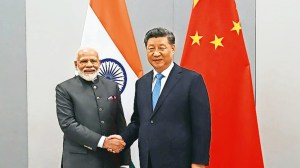Click here to join Express Pune WhatsApp channel and get a curated list of our stories
Pimpri-Chinchwad among top polluted areas in state post Diwali: Report
Post-Diwali air quality analysis for Pune shows significant spike in PM2.5 levels.
 While the PM2.5 levels have dropped compared to last year, when Pimpri-Chinchwad recorded 169 ug/m3 post Diwali, it continues to be higher than the permissible level of 60 ug/m3. (Image: pcmcindia.gov.in)
While the PM2.5 levels have dropped compared to last year, when Pimpri-Chinchwad recorded 169 ug/m3 post Diwali, it continues to be higher than the permissible level of 60 ug/m3. (Image: pcmcindia.gov.in)Pimpri-Chinchwad was among the top polluted areas in Maharashtra post-Diwali with the PM2.5 levels reaching 125.62 μg/m3 on November 1.
While the PM2.5 levels have dropped compared to last year, when Pimpri-Chinchwad recorded 169 ug/m3 post Diwali, it continues to be higher than the permissible level of 60 ug/m3, states the post-Diwali air quality report prepared through the AtlasAQ platform by Respirer Living Sciences Pvt Ltd, a climate-tech startup.
The firm collaborates with institutions such as IIT Kanpur and Duke University and is part of the Centre of Excellence ATMAN on Clean Air Technologies, supported by the Government of India.
According to the report, Maharashtra’s post-Diwali air quality data reveals a significant shift in pollution levels, with tier II cities such as Dhule, Nanded, and Pimpri-Chinchwad recording the highest PM2.5 concentrations in the state. The report shows a substantial increase in PM2.5 levels across the state.
As part of Respirer Living Sciences’ AtlasAQ platform, this report analysed air quality data of Mumbai, Pune, and Nagpur before, during, and after Diwali this year. Using air quality monitoring data from October 30 (pre-Diwali), October 31 (Diwali), and November 1 (post-Diwali), this analysis examines the impact of festival-related pollution on particulate matter levels (PM2.5 and PM10).
When contacted, Avinash Dhakne, member secretary of the Maharashtra Pollution Control Board (MPCB) said they do generallyobserve a dip in air quality levels especially during the festive season. However awareness is increasing about the need for clean air, he added.
In Pune too, according to the System of Air Quality Forecasting and Research (SAFAR) at the Indian Institute of Tropical Meterology (IITM) – the overall air quality post Diwali on November 3 was ‘poor’ with the AQI hovering in the range of 140.
“This analysis provides a detailed look at how Diwali festivities have impacted air quality, underscoring the need for proactive pollution management across both Metro and tier-II cities,” Ronak Sutaria, CEO and founder of Respirer Living Sciences told The Indian Express.
In Pune, PM2.5 levels at Karve Road site increased by 35.7% from 2023, reaching 90.29 μg/m3 this year, indicating a steady rise in pollution post-festivities. Areas such as Hadapsar saw PM2.5 levels climb by 56.3% post-Diwali, showing significant pollution disparities across Pune.
“Post-Diwali air quality data for Pune and Pimpri-Chinchwad reveals troubling spikes in PM2.5 levels, highlighting how festival-related emissions can severely impact air quality even in tier-II urban zones. With cities such as Pimpri-Chinchwad surpassing traditional Metro centres in pollution levels, it is essential to prioritise pollution control and public awareness across the state to protect vulnerable populations. Proactive measures are needed not only in Pune but also in rapidly growing areas like Pimpri-Chinchwad to address the health risks associated with high particulate matter concentrations,” Sutaria said.
Noise levels higher by three-four decibels during Diwali: MPCB
Pune’s Maharashtra Pollution Control Board (MPCB) regional officer J S Salunkhe said noise levels were monitored at various locations, such as Shivajinagar, Karve Road, Satara Road, Swargate, Yerawada, Khadki, Shaniwarwada, Laxmi Road, Saras Baug, Aundh, and University Road. The levels were monitored during the day and at night, a week prior to Diwali and during Diwali.
“We found that the noise levels during Diwali days were higher by at least three to four decibels than what was recorded before the festival commenced,” Salunkhe added.
For instance, at Pimpri’s Shantinagar area, the noise level during the day time on October 24 was 73.1dB whereas on the day of Diwali on November 1, it shot up to 81.0dB.
At Laxmi Road, the noise level during daytime on October 24 was 77.4dB, whereas on November 1, it was 83.2dB.
At almost all locations, the noise levels due to bursting of firecrackers were more than 70dB. The permissible limit during daytime at residential areas is 55 dB while in commercial areas it is 65dB.
Click here to join Express Pune WhatsApp channel and get a curated list of our stories








